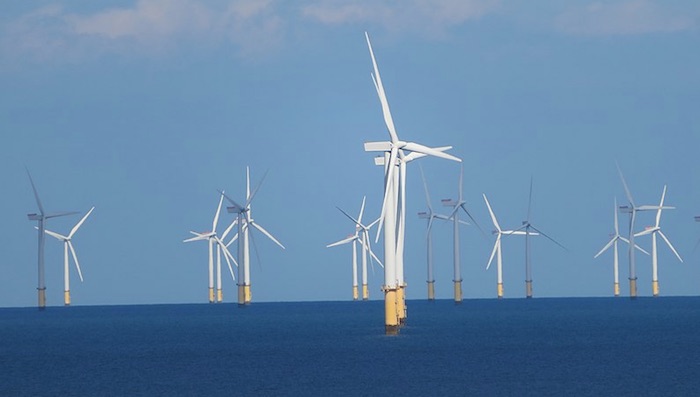
Offshore wind is just an example of infrastructure we can’t build even when the money is there. We are not going to achieve any of our infrastructure goals if we let “visible from the beach” or any number of other local impacts block projects. Here in Vermont people want cell towers but they don’t want to see them; unfortunately they don’t work when they’re hidden in the trees.
This commentary is by Tom Evslin of Stowe, an entrepreneur, author and former Douglas administration official. It is republished from the Fractals of Change blog.
President Biden set a goal of 30 gigawatts (GW) of offshore wind generating capacity for the US by 2030. A medium sized nuclear power plant has a capacity of about one GW — 30 GW can power a lot of electric cars not to mention run factories, keep the lights on, and displace dirty coal. According to an article in Reason: “Last year, the Department of Energy (DOE) made $3 billion available to upgrade ports so the equipment needed to install offshore wind turbines could be shipped out to sea, and the recently passed Inflation Reduction Act (IRA) included measures providing tax credits of up to 30 percent for offshore wind projects that are started before 2026.”

Tom Evslin
Given the tax credits, there’s plenty of private money to finance the actual projects.
Unless there’s regulatory reform, almost no offshore wind is going to get built anytime in the near future.
After decades of effort America currently has only 42 megawatts (MW) of offshore wind capacity with another 932 MW under construction. Altogether, this is less than the output from an average-sized nuclear power plant. 18 GW are in permitting, none of them anywhere near the end of the process. Even when permits are granted, projects are typically delayed decades by after-the -permit appeals and lawsuits. According to Reason: “In July, for example, the DOE’s Bureau of Ocean Energy Management canceled two potential wind energy developments off the coast of Long Island due to concerns that included ‘visibility from nearby beaches.’”
Environmental impact statements take on the average 4.5 years. The tax credits in the IRA for offshore wind are only for projects which begin construction before 2026. Ain’t gonna happen without permitting reform!
Offshore wind is just an example of infrastructure we can’t build even when the money is there. We are not going to achieve any of our infrastructure goals if we let “visible from the beach” or any number of other local impacts block projects. Here in Vermont people want cell towers but they don’t want to see them; unfortunately they don’t work when they’re hidden in the trees. Infrastructure has an impact. That impact must be balanced against the cost of not having the infrastructure. Once the balance has been determined with local input, local interests or competing technologies must not be able to block or substantially delay projects as they can today.
A suggested three-step fix
- All federal permits must be issued or denied within 18 months of application. The requirements must be rigid but predictable.
- We must restate and reassert federal primacy in all interstate projects. This used to be the rule and it is what the Constitution provides for. Politics eroded this so, for example, NY State was allowed to block federally approved pipeline projects to bring much-needed Marcellus gas to New England because that’s what Cuomo wanted.
- No injunctions or restraining orders can be issued for permitted projects unless the opponents post a bond equal to the likely public and private cost of delay. If the appeal succeeds, the project stops (or is changed) and the bond is returned with interest. If the appeal fails, the bond reimburses the cost of delay.
Regulatory reform is a huge opportunity for a bipartisan win for America. The administration must push it. Progressive Democrats won’t support any meaningful deregulation; Republicans should vote to make regulatory reform happen.



Europe already has about 25000 MW offshore, built over the past 30 years
Europe is eager to push the U.S. to build them as well, so they can use their designs in the US and make tons of money.
US companies are newcomers in the offshore area.
The Europeans will give them odds and ends jobs, but not the specialized design, development and manufacturing jobs. Why would they train a competitor?
The end situation will be even worse than the foreign takeover of the US car market
UK, Germany, Denmark, the Netherlands, etc., all require offshore wind turbines to be at least 30 miles offshore to reduce visibility, especially at night, with hundreds of red strobe lights on 850-ft tall wind turbines illuminating the horizon
Modern nuclear plants have two 1200 MW units, for a total output of 2400 x 8766 x 0.90 = 18.7 billion kWh/y.
THIS IS STEADY, NOT VARIABLE, NOT INTERMITTENT, NOT WIND AND SUN DEPENDENT ELECTRICITY
THE PLANT WOULD REQUIRE ABOUT 1000 ACRES
Wind electricity is weather-dependent, too much wind they have to shut down, too little wind, there is no output. In between, output is up and down, 24/7/365
A large capacity, MW, of OTHER power plants ARE ABSOLUTELY NECESSARY to quickly counteract the output variations of wind to maintain grid stability
The more wind, the greater that capacity
Addition
About 4800 MW of offshore wind turbines, 600 units, each about 8 MW, each requiring about 1 to 1.5 square mile of sea area, to avoid blanketing.
The turnkey capital cost for wind turbines, plus connections to shore, plus modifications to high voltage grids would be at least $5 million/MW (2021 dollars), to be amortized over 20 years, based on European offshore experience.
Interest rates will be increasing, raw materials costs will be increasing, project energy costs will be increasing, shipping costs will be increasing, labor costs will be increasing, supply chain disruptions will be ongoing.
All that means, the $5 million/MW will be increasing each year, and the price of electricity production with the higher cost systems, c/kWh, will be increasing each year.
Take a lesson
https://www.foxbusiness.com/politics/experts-blame-green-energy-europes-full-scale-energy-crisis-warning-us
I find it interesting that we see so little about conservation..
There is a whole lot that can be done to save the amount of power we use.. us old timers likely know all the tricks in the book because we want to save money on the electric bills.
But what do the younger people know? do they even think this way? to look at the crowds out there in the big box stores- blowing money on Chinese junk they don’t really need- it appears not.
Playing the Consumerism game is a whole lot of why we are here- and yet who is talking about this?
I am amazed at how dumb people are to build new houses, and lay out new developments and then not even orient the homes to capture the free heat of the sun..
I did this and heated my last house in the winter all day long in the dead of winter just from the heat of the sun.. yes, you can do this.
Where is the building science industry? they are missing their moment here..
The products out there today are amazing.
There is much that can be done that doesn’t even cost a whole lot of money..
I don’t approach this so much from the ‘saving the planet’ standpoint, I look at this more as managing the household budget. The better we are at this, the less we need to work our lives away.
You want to afford to stay home and raise your kids? pay for college? not have a car payment?
Then aim your house south and hang the clothes on a clothesline !!
There is so much that can be done that isn’t done because it doesn’t move the political agenda forward.. this is shameful.
Evslin continues to think climate evangelism is somehow about climate.
It is about money and power.
From Evslin’s solar powered cocoon in Stowe, he urges us to go along with this scam-
Meanwhile in California, EV charging is discouraged during heatwaves and Colorado residents lose control over their Air conditioners during hot temps- as the utility takes control.
Just how long, Mr Evslin- until GMP is required by the VT PSB to take control of your heat pump on a 10 below night in Stowe? That GMP Tesla battery you paid to have will do you no good then, GMP already has control of it.
And in Scotland they cut down 15M trees to put up wind towers. Now, that is green. 15M trees is a drop in the bucket for the green mountain state.
A lot of wisdom here ….. can you imagine building the interstate system, or the electrical grid or ????today? It is not only a renewable energy issue, but in all aspects of life. Our town (Bristol, VT) was successfully denied natural gas through litigation by the opposition. It makes sense to transport fracked fuel oil over land with emission producing trucks than fracked gas through a pipeline. Burlington City Hall park, eventually built, experienced that same resistance. The circ is dead for this reason. It makes more sense to drive through Essex and spew emissions for an extended period of time. The Southern Connector is finally starting after decades of resistance.
Kevin, for all you say, you can thank ONE place….The Conservation Law Foundation….it is they, singlehandidly, who halted so many crucial things…pipelines and IBM circ highway (a 20 YEAR battle with CLF)…because the CLF did not like them. Go ask Stowe Mtn what the CLF did to them. The CLF is NOT a Gov’t body, nor are they ELECTED by the people. But they are “LAWFARE WARFARE” powerful, the can dictate much of VT policies ….. They are a very well funded uber Enviro organization…And if, some day….there is a book legnth obituary written on VT….the CLF will get the longest chapter.
Tom, Trump was already pursuing almost exactly your three-step fix. It’s one of the reasons “The Administrative State” came up with their own twenty-six step fix to get rid of Trump.